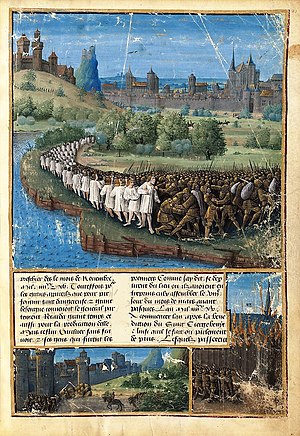 According to Wikipedia, on October 24, 1260, “Chartres Cathedral is dedicated in the presence of King Louis IX of France; the cathedral is now a UNESCO World Heritage Site.” Perhaps they felt that this was a fitting elevation of the Cathedral to truly grand status. It does not feel that way to me.
According to Wikipedia, on October 24, 1260, “Chartres Cathedral is dedicated in the presence of King Louis IX of France; the cathedral is now a UNESCO World Heritage Site.” Perhaps they felt that this was a fitting elevation of the Cathedral to truly grand status. It does not feel that way to me.
The cathedral is a magnificent achievement of Gothic architecture, that stunning and enduring tribute to the vision of the Middle Ages. Nothing, it seems to me, has quite the magnificence of a medieval castle or cathedral. History is still regarded in some circles as a largely unbroken tale of progress, or perhaps a tale of progress with a long dismal medieval dip. But I can think of nothing in all of architecture to rival these sorts of buildings, and in my view most of the stuff that even comes close is older, like the Temple of Hatshepsut.
Chartres is remarkable for a number of reasons including the speed with which it was built, dramatically renovating an older building on a site on which five cathedrals have stood. Hence it does not have the sometimes excessive rambling of buildings put together over centuries with several compelling but not entirely compatible visions directing different parts of the work. It was done when Gothic was at its height and in full possession of its powers and its confidence. And it has survived largely intact.
True, one spire was smitten by lightning in 1506 and rebuilt in the “flamboyant” style that is, as you may guess, rather flamboyant. And it was almost sacked by a mob during the French Revolution before the Revolutionary Committee decided in Taliban-like fashion to blow it up, only to be deterred by a local architect saying the explosion would choke the streets with rubble for years. Then the radicals melted the roof for bullets before arguing that a building without a roof was an expensive hassle to maintain.
The stained glass was wisely removed before World War II and an American Army officer, Col. Welborn Barton Griffith, Jr. saved it from bombing during that conflict by personally scouting to make sure the Germans weren’t using it as an observation post. (He was killed the next day; perhaps God was so impressed He wanted to tell him to his face immediately.)
In 2009 the French Ministry of Culture decided on a major renovation including painting it on the theory that it would look like new. Others have condemned this notion in part because Gothic architecture ages well which you can’t say of the most of the disposable junk we build.
Which brings me to the UNESCO designation. The Cathedral was built as an expression of Roman Catholic religious faith and the civilization to which it had given rise. Something specific, proud and dynamic. The UNESCO designation, by a branch of the worthless-when-not-actively-harmful UN, is bland and anodyne, a grudging admission that it’s a nice relic of something people once thought, to be admired in a bland and ecumenical spirit that has no idea what true and false even are.
I know they meant it as a compliment. But it slides off a building this old, to which modernity has done so much in a militant or self-satisfied spirit that was not an improvement.






